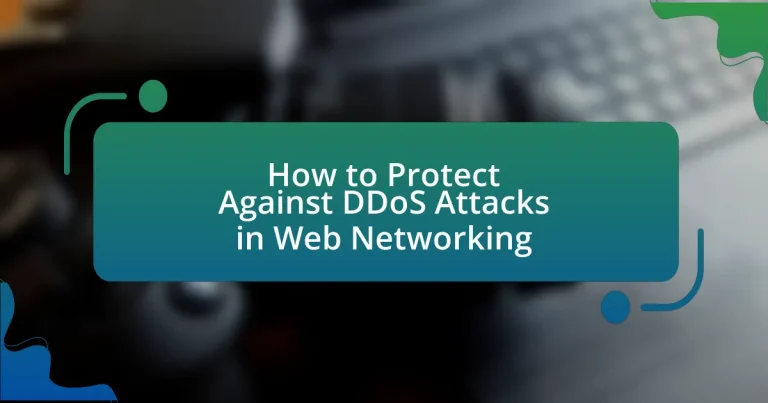DDoS attacks, or Distributed Denial of Service attacks, pose a significant threat to web networking by overwhelming targeted servers, services, or networks with excessive traffic, leading to downtime and financial losses. This article explores the mechanics of DDoS attacks, their various types, and the profound impact they can have on businesses, including revenue loss and reputational damage. It also outlines effective strategies for protection, such as traffic filtering, rate limiting, and the use of DDoS mitigation services, while emphasizing the importance of a multi-layered security approach and incident response planning to enhance resilience against these threats. Additionally, the article discusses the role of employee training and regular security assessments in bolstering defenses against potential DDoS incidents.

What are DDoS Attacks and Why are They a Threat to Web Networking?
DDoS attacks, or Distributed Denial of Service attacks, are malicious attempts to disrupt the normal functioning of a targeted server, service, or network by overwhelming it with a flood of internet traffic. These attacks are a significant threat to web networking because they can incapacitate websites and online services, leading to downtime, loss of revenue, and damage to reputation. According to a report by Cloudflare, DDoS attacks increased by 50% in 2020, highlighting their growing prevalence and potential impact on businesses. The coordinated nature of DDoS attacks, often utilizing a network of compromised devices, makes them difficult to mitigate and defend against, further emphasizing their threat to web networking.
How do DDoS attacks function?
DDoS attacks function by overwhelming a target server, service, or network with a flood of internet traffic, rendering it unable to respond to legitimate requests. This is typically achieved through a network of compromised devices, known as a botnet, which are controlled by the attacker to send massive amounts of traffic simultaneously. According to a report by Akamai, in 2020, the largest recorded DDoS attack peaked at 1.44 terabits per second, illustrating the scale at which these attacks can operate. The goal of a DDoS attack is to disrupt the normal functioning of the target, causing downtime or degraded performance, which can lead to significant financial losses and damage to reputation.
What types of DDoS attacks exist?
There are several types of DDoS attacks, including volumetric attacks, protocol attacks, and application layer attacks. Volumetric attacks, such as UDP floods and ICMP floods, aim to overwhelm the bandwidth of the target by sending massive amounts of traffic. Protocol attacks, like SYN floods and Ping of Death, exploit weaknesses in network protocols to disrupt services. Application layer attacks, such as HTTP floods, target specific applications to exhaust server resources. Each type of attack has distinct characteristics and methods of execution, making them effective in different scenarios.
How do attackers execute DDoS attacks?
Attackers execute DDoS (Distributed Denial of Service) attacks by overwhelming a target’s network or server with a flood of traffic from multiple compromised devices, often referred to as a botnet. This coordinated effort can involve various methods, such as sending excessive requests, exploiting vulnerabilities, or using amplification techniques to increase the volume of traffic directed at the target. For instance, in 2018, the GitHub DDoS attack peaked at 1.35 terabits per second, demonstrating the potential scale and impact of such attacks.
What impact do DDoS attacks have on businesses?
DDoS attacks significantly disrupt business operations by overwhelming servers with traffic, leading to downtime and loss of revenue. For instance, a study by the cybersecurity firm Corero found that 40% of businesses experience a revenue loss of up to $100,000 per hour during such attacks. Additionally, these attacks can damage a company’s reputation, as customers may lose trust in a business that frequently suffers outages. The financial implications extend beyond immediate losses, as recovery costs and potential legal liabilities can accumulate, further impacting the bottom line.
How can DDoS attacks affect website performance?
DDoS attacks can severely degrade website performance by overwhelming the server with excessive traffic, rendering it unable to respond to legitimate user requests. This influx of malicious traffic can lead to increased latency, downtime, and ultimately, a complete service outage. For instance, a study by the cybersecurity firm Akamai reported that DDoS attacks can increase response times by up to 50% and cause significant disruptions in service availability. Consequently, websites may experience slow loading times or become entirely inaccessible, negatively impacting user experience and potentially leading to financial losses for businesses.
What are the financial implications of a DDoS attack?
A DDoS attack can lead to significant financial implications, including direct costs from lost revenue due to downtime and indirect costs such as damage to brand reputation and customer trust. For instance, a study by the Ponemon Institute found that the average cost of a DDoS attack for organizations can exceed $2 million, factoring in lost business, IT costs, and recovery expenses. Additionally, companies may incur costs related to increased security measures and potential legal liabilities, further compounding the financial impact.

What Strategies Can Be Implemented to Protect Against DDoS Attacks?
To protect against DDoS attacks, organizations can implement strategies such as traffic filtering, rate limiting, and using DDoS mitigation services. Traffic filtering involves identifying and blocking malicious traffic before it reaches the network, which can be achieved through firewalls and intrusion detection systems. Rate limiting restricts the number of requests a user can make to a server within a specific timeframe, effectively reducing the impact of an attack. Additionally, employing DDoS mitigation services, which are specialized solutions that absorb and disperse attack traffic, can significantly enhance an organization’s resilience against such threats. According to a report by the Cybersecurity and Infrastructure Security Agency, organizations that utilize these strategies can reduce the risk of service disruption during DDoS attacks.
How can network architecture be designed for DDoS resilience?
Network architecture can be designed for DDoS resilience by implementing a multi-layered defense strategy that includes traffic filtering, redundancy, and scalability. Traffic filtering involves deploying intrusion detection systems and firewalls that can identify and block malicious traffic patterns before they reach critical infrastructure. Redundancy ensures that multiple servers and data centers are available to handle traffic, distributing the load and minimizing the impact of an attack. Scalability allows the network to absorb sudden spikes in traffic by utilizing cloud-based resources or content delivery networks (CDNs) that can dynamically allocate bandwidth. These strategies are supported by industry practices, such as the use of Anycast routing, which directs traffic to the nearest data center, thereby enhancing response times and reducing the risk of overload on any single point in the network.
What role do load balancers play in DDoS protection?
Load balancers play a critical role in DDoS protection by distributing incoming traffic across multiple servers, thereby preventing any single server from becoming overwhelmed. This distribution helps to absorb and mitigate the impact of DDoS attacks, which typically aim to flood a target with excessive traffic. By managing traffic effectively, load balancers can maintain service availability and performance during an attack, ensuring that legitimate users can still access the services. Additionally, many load balancers incorporate advanced features such as traffic filtering and rate limiting, which further enhance their ability to defend against DDoS threats.
How can redundancy enhance network security?
Redundancy enhances network security by providing multiple pathways and resources to maintain service availability during attacks or failures. In the context of DDoS attacks, redundancy ensures that if one server or network path is overwhelmed, others can take over, thereby distributing the load and minimizing downtime. For instance, implementing load balancers and multiple data centers can effectively mitigate the impact of a DDoS attack, as evidenced by studies showing that organizations with redundant systems experience significantly less service disruption during such events.
What security tools and services are available for DDoS protection?
Security tools and services available for DDoS protection include cloud-based DDoS mitigation services, on-premises hardware appliances, and hybrid solutions. Cloud-based services, such as those offered by Akamai, Cloudflare, and Amazon Web Services, provide scalable protection by redirecting traffic through their networks to filter out malicious requests. On-premises appliances, like those from Arbor Networks and Radware, offer real-time traffic analysis and filtering capabilities directly at the network edge. Hybrid solutions combine both cloud and on-premises technologies to provide comprehensive protection. According to a report by Gartner, organizations using these tools can reduce the impact of DDoS attacks significantly, with some services capable of mitigating attacks exceeding 1 Tbps.
How do DDoS mitigation services work?
DDoS mitigation services work by detecting and filtering out malicious traffic aimed at overwhelming a network or server. These services utilize various techniques such as traffic analysis, rate limiting, and IP blacklisting to differentiate between legitimate and harmful requests. For instance, according to a report by the Cybersecurity and Infrastructure Security Agency (CISA), effective DDoS mitigation can reduce the impact of attacks by up to 90% through real-time traffic monitoring and automated response systems. This ensures that only valid traffic reaches the targeted resources, maintaining service availability during an attack.
What are the benefits of using a Web Application Firewall (WAF)?
A Web Application Firewall (WAF) provides several benefits, including enhanced security, protection against common web vulnerabilities, and improved compliance with regulations. WAFs specifically filter and monitor HTTP traffic between a web application and the Internet, effectively blocking malicious requests and preventing attacks such as SQL injection and cross-site scripting. According to a report by Gartner, organizations that implement WAFs can reduce the risk of data breaches by up to 50%, demonstrating their effectiveness in safeguarding sensitive information. Additionally, WAFs can help maintain compliance with standards like PCI DSS by ensuring that web applications adhere to security best practices.

How Can Organizations Prepare for Potential DDoS Attacks?
Organizations can prepare for potential DDoS attacks by implementing a multi-layered security strategy that includes traffic analysis, redundancy, and incident response planning. Traffic analysis tools help identify unusual patterns that may indicate an impending attack, allowing organizations to respond proactively. Redundancy measures, such as load balancing and failover systems, ensure that services remain available even during an attack. Additionally, having a well-defined incident response plan enables organizations to quickly mobilize resources and mitigate the impact of an attack. According to a report by the Cybersecurity and Infrastructure Security Agency (CISA), organizations that adopt these strategies can significantly reduce downtime and maintain service continuity during DDoS incidents.
What proactive measures should be taken to mitigate risks?
To mitigate risks associated with DDoS attacks in web networking, organizations should implement a multi-layered security approach. This includes deploying firewalls and intrusion detection systems to filter malicious traffic, utilizing rate limiting to control the volume of requests, and employing content delivery networks (CDNs) to absorb traffic spikes. Additionally, regular security audits and vulnerability assessments can identify potential weaknesses in the network infrastructure. According to a report by the Cybersecurity and Infrastructure Security Agency, organizations that adopt these proactive measures significantly reduce their exposure to DDoS threats, enhancing overall network resilience.
How can regular security assessments help in DDoS preparedness?
Regular security assessments enhance DDoS preparedness by identifying vulnerabilities and weaknesses in a network’s infrastructure. These assessments allow organizations to evaluate their current security measures, ensuring they can withstand potential DDoS attacks. For instance, a study by the Ponemon Institute found that organizations conducting regular security assessments experienced 30% fewer successful DDoS attacks compared to those that did not. By proactively addressing identified weaknesses, organizations can implement stronger defenses, such as improved traffic filtering and redundancy measures, thereby reducing the risk and impact of DDoS incidents.
What incident response plans should be in place for DDoS attacks?
Incident response plans for DDoS attacks should include preparation, detection, mitigation, and recovery strategies. Preparation involves establishing a response team, creating communication protocols, and developing a playbook that outlines specific actions to take during an attack. Detection requires implementing monitoring tools to identify unusual traffic patterns indicative of a DDoS attack. Mitigation strategies may involve deploying rate limiting, traffic filtering, or using DDoS protection services to absorb and redirect malicious traffic. Recovery focuses on restoring services, analyzing the attack for lessons learned, and updating the incident response plan accordingly. These structured steps ensure a comprehensive approach to effectively manage DDoS incidents.
What are the best practices for ongoing DDoS protection?
The best practices for ongoing DDoS protection include implementing a multi-layered defense strategy, utilizing traffic analysis tools, and maintaining an incident response plan. A multi-layered defense strategy involves using firewalls, intrusion detection systems, and DDoS mitigation services to filter malicious traffic effectively. Traffic analysis tools help in identifying unusual patterns that may indicate an impending attack, allowing for proactive measures. Additionally, having an incident response plan ensures that organizations can quickly react to DDoS attacks, minimizing downtime and service disruption. According to a report by the Cybersecurity and Infrastructure Security Agency (CISA), organizations that employ these strategies significantly reduce their vulnerability to DDoS attacks.
How can organizations stay updated on emerging DDoS threats?
Organizations can stay updated on emerging DDoS threats by subscribing to threat intelligence services and participating in cybersecurity forums. These services provide real-time alerts and detailed reports on the latest DDoS attack vectors and trends, enabling organizations to adapt their defenses accordingly. For instance, the Cybersecurity and Infrastructure Security Agency (CISA) regularly publishes advisories and updates on DDoS threats, which organizations can utilize to enhance their security posture. Additionally, engaging with industry-specific cybersecurity groups allows organizations to share experiences and strategies, further strengthening their defenses against evolving threats.
What role does employee training play in DDoS defense?
Employee training plays a crucial role in DDoS defense by equipping staff with the knowledge and skills to recognize and respond to potential threats effectively. Trained employees can identify unusual network traffic patterns indicative of DDoS attacks, enabling quicker response times and mitigation efforts. Research indicates that organizations with comprehensive cybersecurity training programs experience 45% fewer security incidents, highlighting the effectiveness of training in enhancing overall security posture. Additionally, informed employees are less likely to fall victim to social engineering tactics that could facilitate DDoS attacks, further strengthening the organization’s defenses.
What practical steps can organizations take to enhance their DDoS defenses?
Organizations can enhance their DDoS defenses by implementing a multi-layered security approach that includes traffic filtering, rate limiting, and the use of DDoS mitigation services. Traffic filtering allows organizations to identify and block malicious traffic before it reaches their network, while rate limiting helps control the amount of traffic sent to servers, preventing overload. Additionally, utilizing DDoS mitigation services, such as those offered by cloud providers, can absorb and disperse attack traffic, ensuring that legitimate users maintain access. According to a report by the Cybersecurity & Infrastructure Security Agency (CISA), organizations that adopt these strategies significantly reduce their vulnerability to DDoS attacks, demonstrating the effectiveness of a proactive defense strategy.




